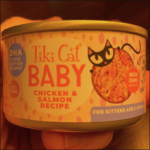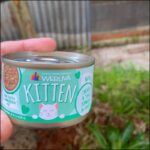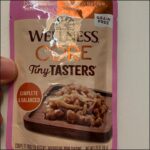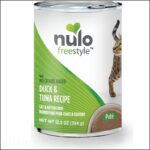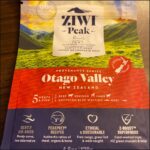Quick answer: The best way to help gassy kittens is to limit or avoid foods with fermentable carbohydrates.
Peas, chickpeas, lentils (legumes) and starchy foods are examples of fermentable carbohydrate.
Try limiting them in your kittens diet to help with flatulence.
5 Best Cat Food for Gassy Kittens
Tiki Cat Baby is my preferred choice as it is low fiber and contains no added starch, but there’s others worth trying too.
How I Selected These Cat Foods?
I filtered cat foods to help with gas.
I excluded cat foods with:
- Peas
- Beans
- Soybeans
- Pinto beans
- Lentils
- Added milk (lactose)
- Foods high in resistant starch (e.g. rice)
- Cruciferous vegetables (e.g. broccoli)
- Carrageenan
- Added fruits
- Gums (if possible)
- Supplemental cat foods (don’t provide complete nutrition)
To learn more about how I calculate and grade food, check out our review guidelines.
More below in this guide to the best cat food without carrageenan.
I have a background in nutrition and research and test most of the products recommended.
This article isn’t a replacement for medical advice.
See more about us here.
What to Look For in the Cat Food For Gassy Kittens?
Quick answers:
- Limit legumes
- Hard to digest; high in oligosaccharides.
- Include peas, chickpeas, lentils, pinto beans.
- Cause smelly farts due to fermentation by bacteria.
- Avoid or minimize in kitten food.
- Functional foods
- No proven benefits for gas relief in kittens.
- Include prebiotics, probiotics, herbs, gums.
- Some decrease taurine digestibility; gums (e.g. xanthan gum) increase gas.
- Choose wet food without gums if possible.
- High carb diets
- Cats don’t need carbs.
- High carb diets may interfere with digestion.
- Can cause gas and diarrhea.
- Limit carbs to <25% of total calories.
- Allergies
- Can cause flatulence, along with itching, vomiting, diarrhea.
- May require an elimination diet under vet supervision.
- Limited ingredient or novel protein diets can help.
- Choosing food for kittens.
- Look for high protein and calorie intake for growth.
- Opt for foods labeled for growth or all life stages.
- Choose animal-based food sources.
Long answers:
Common Causes of Gas in Kittens
Legumes
Legumes are hard to digest.
They’re high in oligosaccharides, a type of starch that resists digestion.
Legumes include things like:
- Peas
- Chickpeas
- Lentils
- Pinto beans
Undigested food is a fuel for bacteria.
Bacteria ferment this undigested food, and it creates gas. That makes your kitten produce smelly farts.
Since these foods offer no proven benefit, it’s best to steer clear of them.
Failing that, try to choose products with less of these ingredients.
The higher on the ingredient list, the more of the ingredient. Foods with peas as a main ingredient aren’t ideal.
Quick notes:
- Legumes include peas, chickpeas, lentils and pinto beans.
- These foods are high in oligosaccharides, a type of starch that resists digestion.
- Choose kitten food with lower amounts of legumes for relief from smelly farts.
Functional Foods
Functional foods sound great for health…
However, there’s no proven functional foods that help with gas in kittens.
Functional foods include:
- Prebiotics
- Probiotics
- Chinese rhubarb
- Rice bran
- Apple pomace
- Herbs
- Gums
Some ingredients such as rice bran and apple pomace decrease taurine digestibility. This is bad since taurine maintains heart and eye health.
Gums and pectin have rapidly fermenting fibers that increase gas. They don’t benefit kittens.
Unfortunately gums are common in many wet cat foods so it’s hard to get away from this ingredient. But if things don’t improve, it’s worth looking into wet cat food without gums.
Quick notes:
- Functional foods include prebiotics, brans and other ‘super foods’ (e.g. apple pomace).
- They aren’t proven to improve the health of cats, based on research.
- Gums are high in fermentable fiber, which can increase gas.
High Carb Diets
Cats don’t need carbs.
Diets exceeding 25% carbs (dry matter) are hard to digest. Many dry kitten foods go over this.
Cats have fewer enzymes for carb digestion than humans. They digest cooked starch – up until a point (you won’t hear this talked about much).
It’s the total amount that’s the problem, as high carb diets causing gas and diarrhea.
How do you find out if you’re giving your cat too much?
Use a calculator.
It takes a minute, but well worth the trouble. Punch in the guaranteed analysis and check for dry matter carb content.
If it’s exceeding 25%, it’s not worth it. Experts suggest limiting carbs to 12% for best results.
Quick notes:
- Cats have no requirement for carbohydrate.
- They can digest small amounts of carbohydrate, but struggle with higher intakes.
- Limit carbohydrate to < 25% (dry basis) of the total calories to help with digestion.
Allergies
It’s also possible for allergies to cause flatulence in kittens.
The problem is that many foods can cause allergies.
Food allergies also involve symptoms such as itching, vomiting, and diarrhea. If you suspect an allergy, you’ll need to conduct an elimination diet with the help of a vet.
Other Things to Look for When Choosing Food for Gassy Kittens
Check the Statement of Nutritional Adequacy
Kittens need more nutrition to help support growth.
A kitten reaches adulthood in one year, giving you a short window to help them develop. They need more protein and calories.
Check the statement of nutritional adequacy. Food should be for either all life stages or growth.
Animal food sources are the best choice for kittens, as carnivores. They are easier to digest and break down.
Kittens need animal-based foods as they provide the nutrients needed for growth.
Quick notes:
- Kittens reach adulthood in one year.
- They need a higher calorie and protein intake to help support rapid growth.
- Choose food suited to either all life stages or growth.
FAQ
Conclusion
Gas in kittens is often caused by eating too much fermentable ingredients.
This includes legumes, dairy, resistant starch and gums. Offering food without these ingredients can help relieve gas.
If the problem persists, speak with a vet for help. Parasites and allergies are other things that can lead to gas in kittens.
>> Our top recommended option for gassy kittens is Tiki Cat Baby. It’s free of peas, grains, gums and other irritating ingredients.
Related:

